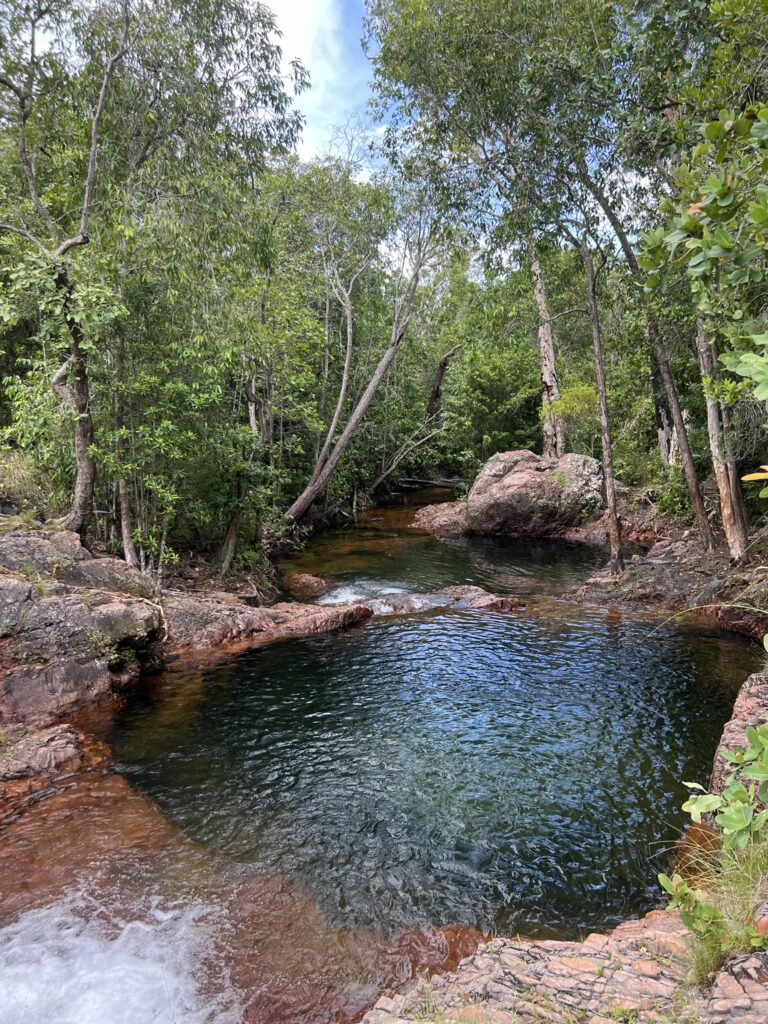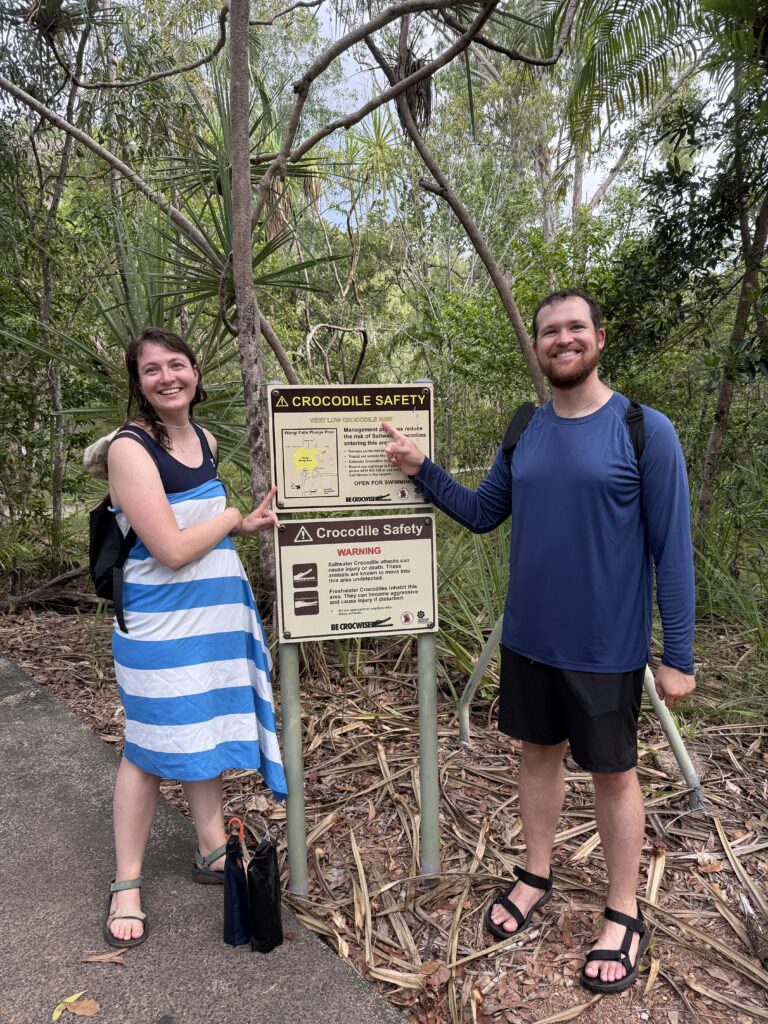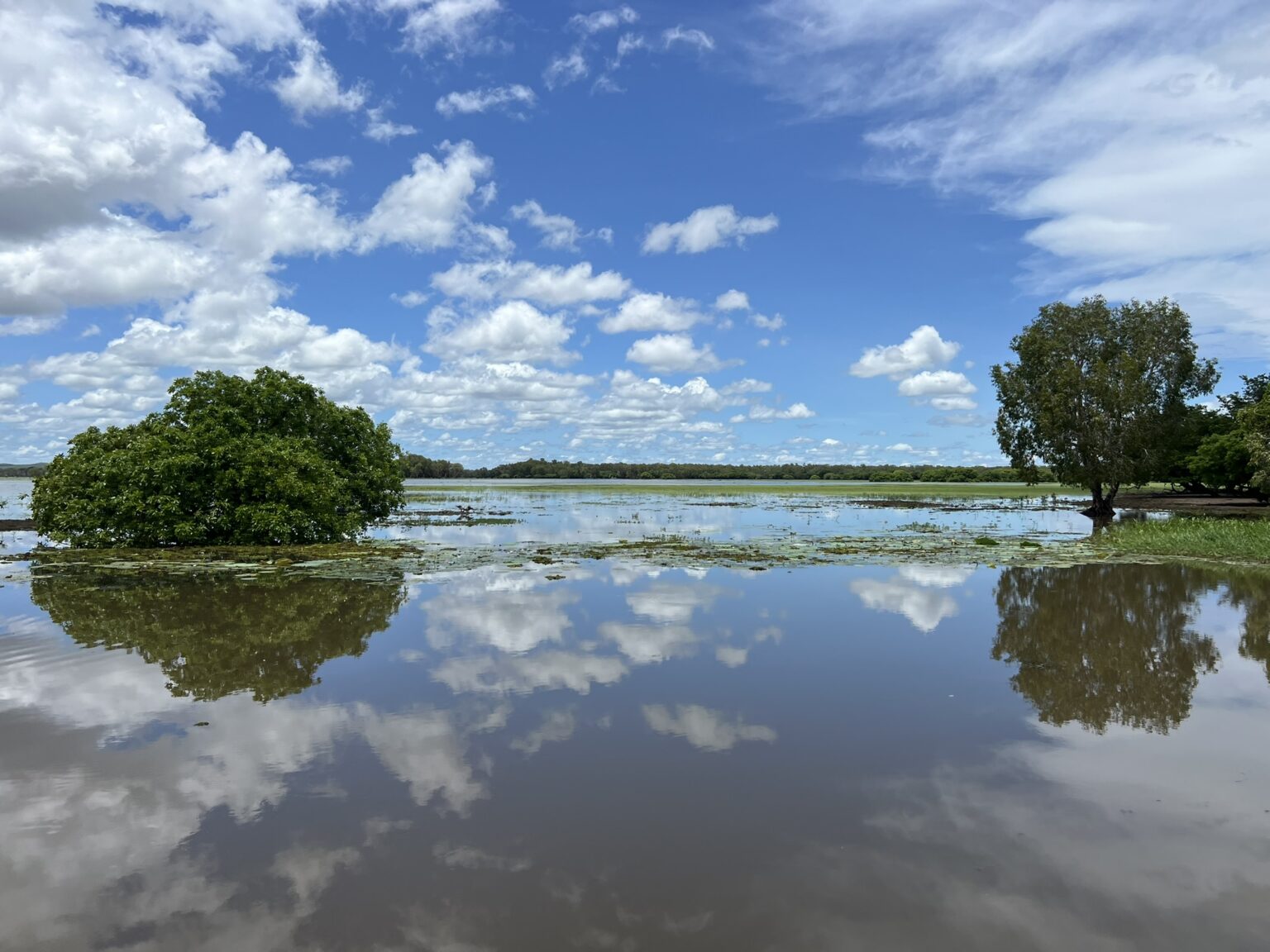This past week, we had an eventful time in the Darwin region of Australia, also known as the Top End. Besides the Red Desert of Uluru, many people think of this region when they think of the landscapes and wildlife of Australia because of Crocodile Dundee, which was filmed in this part of Australia. And yes, there really are enormous saltwater crocodiles all around this area. Wherever we saw pools of water or a shoreline, we avoided approaching the water, knowing that a crocodile could be lurking right under the surface.
These animals, while often between 10-17 feet (3-5 meters) long, are so stealthy and agile that most animals and humans have very little chance of getting away from them if within their territory and water source. We got the opportunity to see them in their natural habitat through different river tours with crocodiles swimming in the water and resting on shore. We also stopped at some pubs throughout the Top End area that had their own pet crocodiles on their properties, another aspect that aligns with the culture portrayed in the Crocodile Dundee movie.
This region was unlike anywhere else we’ve been in Australia. Even the city had a wild and rugged vibe to it. And what it lacked in European refinement, it more than made up for with a “wild-west” personality. People come to the Northern Territories to find themselves, go on off-the-grid adventures, start a new life, etc. The Top End also has the largest concentration of Aboriginal people in Australia, making it a diverse and unique part of the country. (The region is hard to inhabit due to the climate and European settlers did not displace as many the people of this area.) We loved getting to learn more about this diversity, including the different Aboriginal people throughout the area and the influx of Asian immigrants in this part of the country, which has had a large impact on Darwin.
Destination Overview
Australia’s Top End from Darwin
Darwin is the capital of the Northern Territory located in the far north of Australia in a geographic region referred to as the Top End. Approximately half of the Northern Territory population lives in the city which is located closer to Indonesia, Timor-Leste, and Papua New Guinea than Sydney. This proximity to Southeast Asia has resulted in a multicultural city that has a variety of different cafes, restaurants, and events. This proximity to Asia also meant that this city was impacted by the fighting that happened in the Pacific Ocean during World War II. During the war, Japan mounted the largest single attack against Australia by a foreign power by bombing the city of Darwin. Today, there are museums as well as memorials dedicated to the Bombing of Darwin throughout the city.

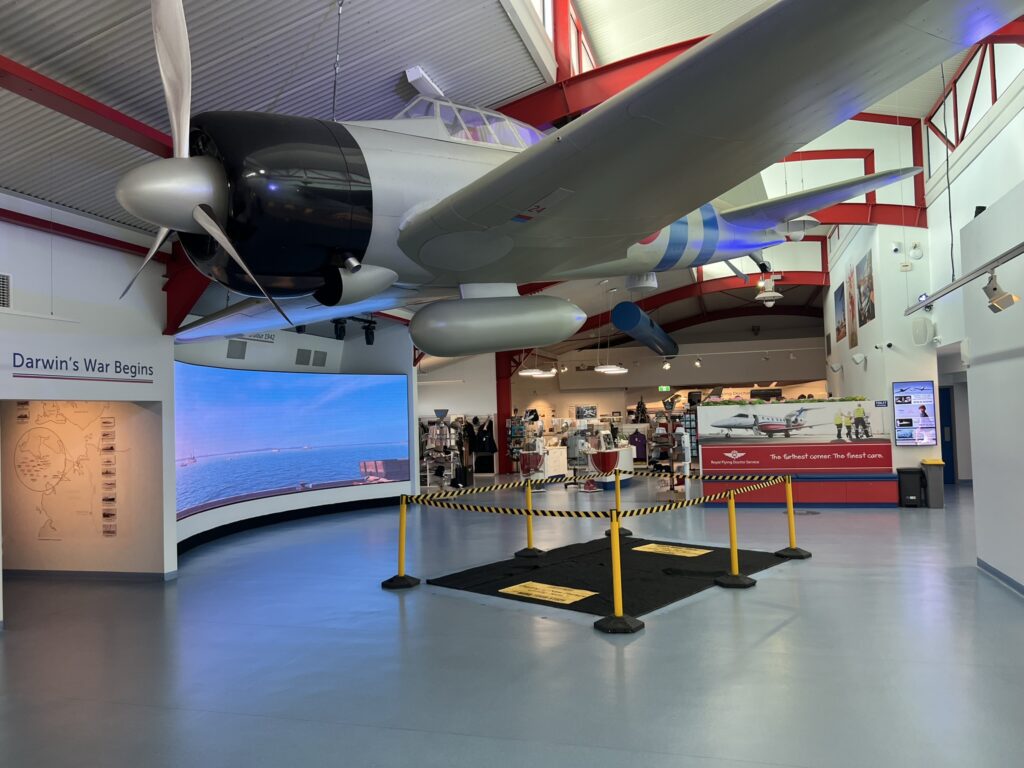
Darwin is most popular with tourists that want to explore the outdoors in this unique region of the country because it is near Litchfield, Kakadu, and Nitmiluk National Parks. While the area is still considered the Outback, it does not have the stereotypical red dirt and arid environment of Central Australia. Rather the region is situated in the tropics meaning that there are thunderstorms, heavy rain, flooding, and occasionally devastating cyclones.
Additionally, the region has both saltwater (salties) and freshwater (freshies) crocodiles. One of the most famous saltwater crocodiles was known as Sweetheart and was 16.7 feet long (5.1 meters) and over 1,700 pounds (780 kilograms). Sweetheart enjoyed attacking boats in the 1970s and, in an attempt to remove the crocodile from the waterway, it was accidentally drowned. Sweetheart was brought to a taxidermist and today is displayed at the Museum and Art Gallery of the Northern Territory in Darwin. Saltwater crocodiles are very territorial and aggressive so it is important to abide by signs throughout the region that indicate whether to enter bodies of water, especially taking extra care during monsoon season as the flooding enables salties to live in unexpected places.
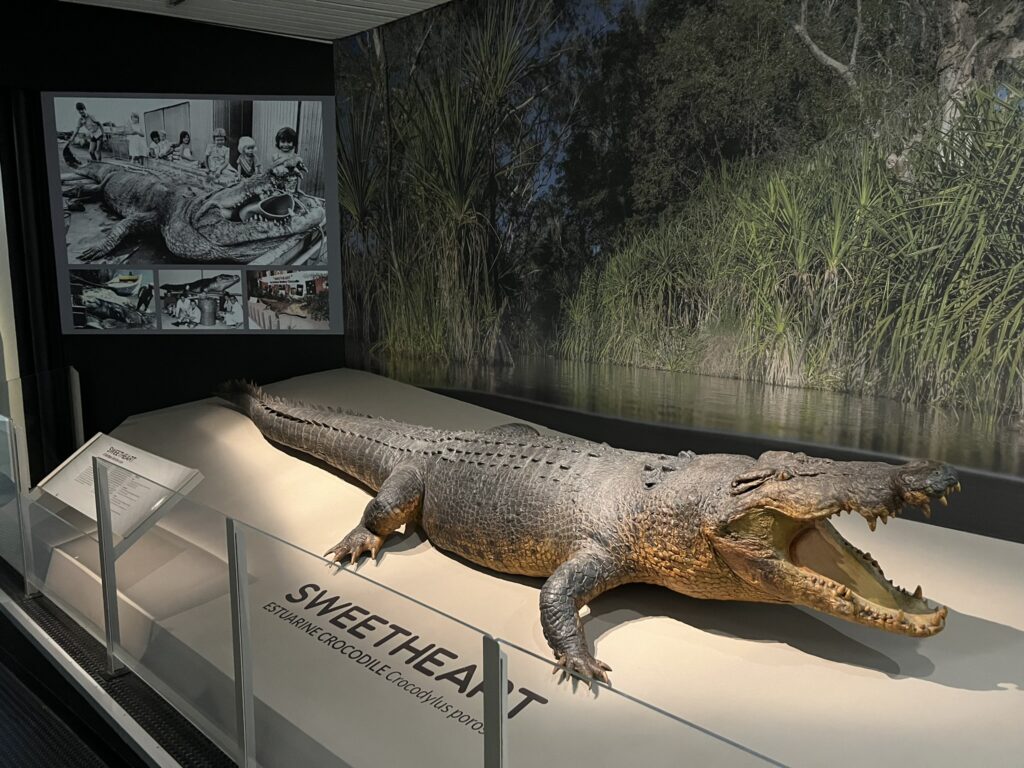
Where to Read More
How to Best Explore Darwin + the Top End of Australia (Itinerary Included)
A sample itinerary for visiting Darwin, Australia with ways to learn more about the Aboriginal culture and see some of the infamous wildlife.
An Interesting Fact
Aboriginal Rock Art Taught Important Knowledge
It is believed that the first humans arrived in Australia nearly 65,000 years ago. Besides oral communication, one of the primary ways to archive information was through rock engravings and drawings. Archeologists have found tools dating 50,000 years ago in Australia that could have allowed for rock drawings to be created. The oldest fragments of rock art found in Australia are thought to be from 30,000 years ago with the oldest fully intact being a kangaroo, which is over 17,000 years old. All throughout the Australian continent, there are believed to be more than 100,000 significant art sites with more than 5,000 found in the Kakadu National Park.
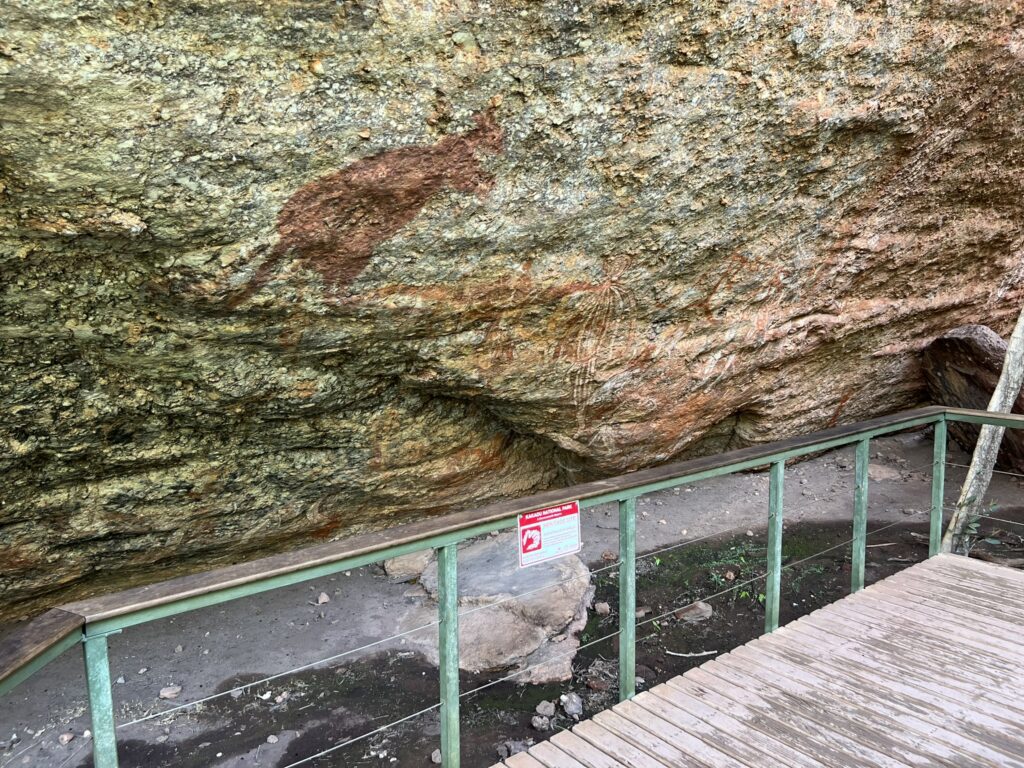
One of our primary motivations for visiting Australia’s Top End was to visit Kakadu National Park to see the rock art and learn more about the Aboriginal culture. We decided that a guided tour of Kakadu would be most beneficial to get the most out of the visit and booked a full day Kakadu Cultural Exploration from Darwin with Cyaround Australia Tours. Cyaround is a tourism business owned by an Australian husband and wife team that has a passion for small group personalized experiences. While we would have liked to book a multi-day tour of the region, our schedule only allowed for a brief introduction to Kakadu, a national park that is about the same size as the entire state of New Jersey. Based on our experience with our tour guide and co-owner Jack, we would like to return to this region to continue exploring Kakadu and more in the surrounding area.
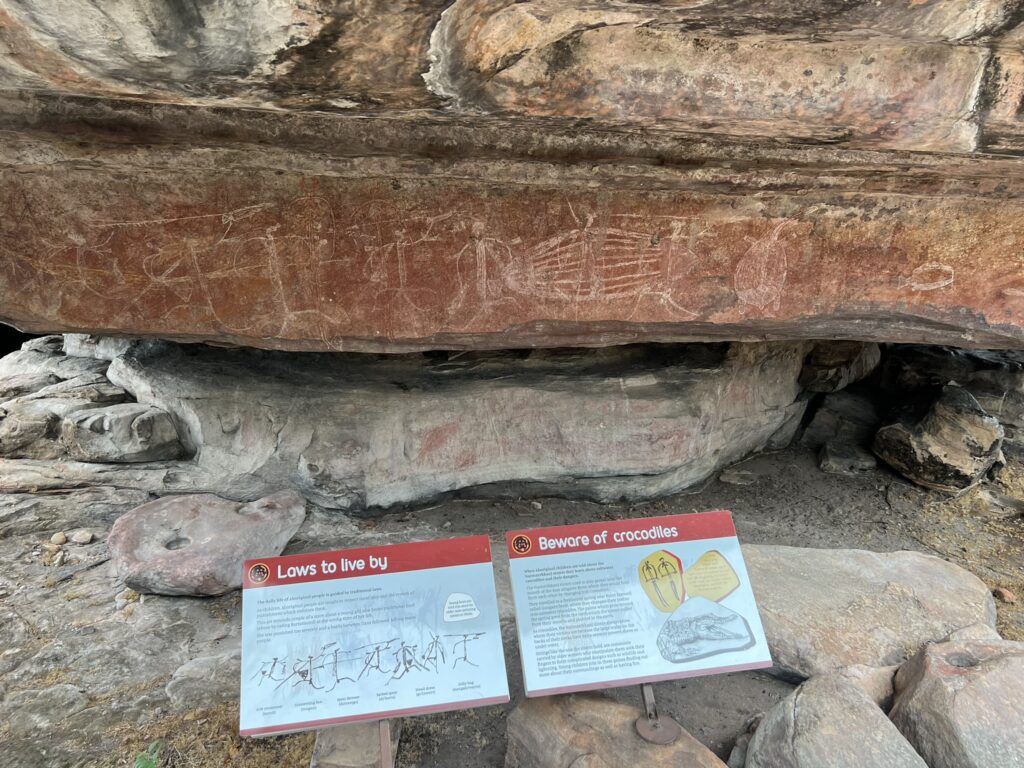
During our Kakadu Cultural Exploration with Jack we visited Anbangbang Rock Shelter, Ngurrungurrudjba (Yellow Water), Warradjan Aboriginal Cultural Centre, Cahills Crossing, and Ubirr Art Site. While some of the stops were to admire the natural beauty and wildlife of Kakadu, the majority were to learn more about the rock art. Through a combination of informational displays and Aboriginal knowledge that had been passed on to Jack, we learned more about the specific rock art in Kakadu. It turned out that much of the rock art was actually important knowledge that helped the Aboriginal people survive in this harsh environment. We even passed through an area that was believed to be similar to a classroom where people used to come to learn the information through the rock art. Through our visit to Kakadu we received a great introduction to the basics of the Aboriginal rock art but would like to return to learn even more.

Travel Tip of the Week
Pick the Correct Season to Visit Darwin based on Your Desired Activities
Unlike many places that have the traditional 4 seasons (summer, fall, winer, spring) or 2 seasons (wet, dry), Darwin is said to have 6 seasons which have been understood by the Aboriginal population for thousands of years. These 6 seasons drastically impact life in Australia’s Top End and are important to consider when planning your trip to the region. Certain activities may not be possible during parts of the year due to storms and rains. These storms also dictate life for the animals and in a short time can transform landscapes to lush forests which means visiting throughout different time periods will almost feel like an almost different place. Below are descriptions of the different seasons so that you can use them to determine when is best for your visit to Australia’s Top End.
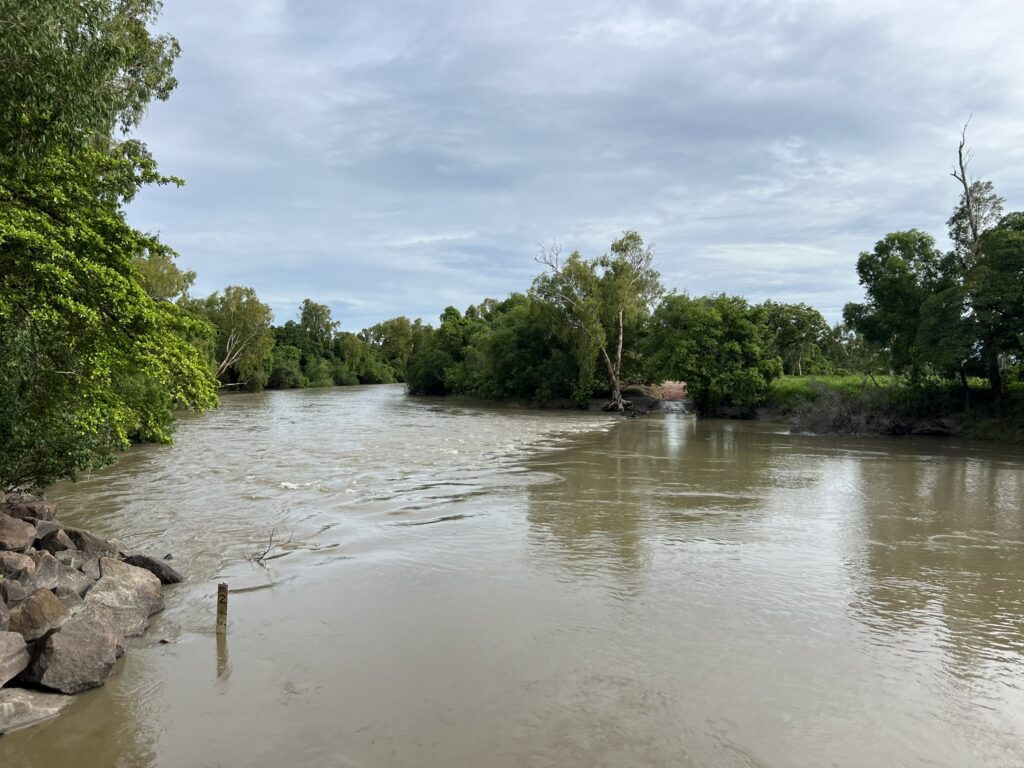
December - March
Kudjewk - Monsoon Season
This time of year humidity can be around 80% and heavy rains cause flooding which creates issues with roads and shuts down many activities. This flooding enables saltwater crocodiles to enter bodies of water throughout the region causing closures of traditional swimming holes. Powerful cyclones can hit during this time such as the 1974 Cyclone Tracy which destroyed nearly 80% of the homes in Darwin. During our visit Cyclone Tracy was being commemorated with a special 50th anniversary exhibit at the Museum and Art Gallery of the Northern Territory.
April
Knock Em Down Storm Season
The severe monsoon storms begin to subside which allows for flooding to start receding in the area. There are still impressive storms that bring violent winds flattening speargrass which is how this time of year earned the name of Knock Em Down Storm Season. Temperatures during this time of year are normally between 73 F (23 C) to 93 F (34 C) and the high humidity is similar to Monsoon Season.
May - June
Yekke - Cooler Season
The temperatures are still around the same level of degrees but the big difference is that humidity drops significantly. It is around this time of year that tourism begins to pick up again as many of the areas that were closed due to flooding are reponed. The Aboriginal population are notified by dry winds that it is a time of the year for controlled burns that enable new growth in the seasons ahead.
June - August
Wurrkeng - Cold Season
For this region the cold season means temperatures drop to around 62 F (17 C) but still are around 90 F (32 C) during the day. Humidity still is low during this time of year making it pleasant for travelers wanting to explore the national parks such as Kakadu. Floodplains begin to dry out meaning birds and animals are occupying the same areas with less food after a time of abundance.
August - October
Kurrung - Hot Dry Season
Temperatures climb to nearly 100 F (37 C) but humidity continues to stay low. Most of the land is parched from lack of rain and it is a great time to take advantage of swimming throughout the region such as Litchfield National Park’s popular Florence Falls, Bulley Rockhole, and Wangi Falls. Towards the end of this season thunder clouds begin to build and tourism slows.
October - December
Kunumeleng - Pre Monsoon Season
The length of time for this season varies year to year but is marked by increasing humidity on top of the hot temperatures. As soon as a few thunderstorms hit the land begins to transform to a lush green color again. Aboriginal people used to relocate from floodplains to shelters in anticipation of the coming monsoons. It is a unique time to visit because you may be able to still enjoy swimming in Litchfield, explore Kakadu, and watch the impressive thunderstorms all with little other tourists in the region.
